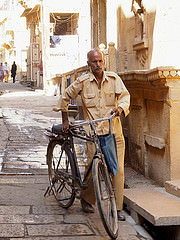by Parameswaran Krishna
The other day, a series of letters and parcels were delivered to me at my home by a prominent courier service company. I could only nostalgically reminiscence about the good old days of the khakhi-clad post man and the cheerful conversations we used to have with him and the morsels of local gossips that he used to supply me and my friends!
The iconic “long, short” story by the renowned Malayalam romantic writer and Gyanpeedh winner S K Pottekkat also starts with a remembrance of the ubiquitous post man. The story, replete with poetic descriptions of nature and of unsullied rural pockets of Kerala, starts with Devayani, the heroine, impatiently awaiting the sight of the khakhi head dress of the post man!
However, the uncrowned “prince” amongst the various services offered by the erstwhile Posts and Telegraph department was the telegram service! The arrival of the telegram used to signal a momentous happening and the number of films where the arrival of telegrams signalled the turn of the plot is simply too numerous to be counted!
Against this background, it seems serendipitous that I met up recently with an aged employee of the postal department who had much to say about the telegraph services. K P Balakrishnan, joined the postal department in the sixties, after meritoriously serving the Indian Air Force.
At that time, the telegraph services were reigning supreme. Balakrishnan, in his capacity as a postal assistant, had the fortune to serve in various small post offices in the erstwhile Malabar area – like Edappal, Ponnani etc. One of his clearest memories of the post offices of those days was the incessant “kattu kadu kadu” chatter of the telegraph machine!
The telegraphist was an important personage in those days. He could even get away with a “talking to” from the post master himself – just by claiming that the telegraph machine needed his immediate attention!
The telegraphist’s stature was high for another reason also – only people with some command of English were usually selected for the post. They had to undergo rigorous eight month training in far off places like Trivandrum, Madras etc before being given appointments even in small post offices.
Another interesting nugget of information that Balakrishnan had to pass on was the importance given to spelling of words those days. It would seem antediluvian to the present generation of SMSers and e mailers, who have the freedom to spell words “any which way they want”! In those days, before the advent of the system of pincode numbers, the misspelling of a place name would result in the urgent, express telegram being sent to a totally different place and returned to the place of origin – “addressee unknown”! Palghat in Kerala was wont to be confused with Palghar in Orissa; there is a Gandhinagar in Madurai, Tamil Nadu as well as the more famous Gandhinagar, capital of Gujarat!
But what I felt to be most interesting was Balakrishnan’s recounting of the then prevalent system of “abbreviated telegraphic addresses”. This was followed even in small post offices like the one Balakrishnan served – Edappal. A person who sends or receives a lot of telegrams can have an abbreviated telegraphic address registered in his name. The abbreviated address must fulfil certain criteria. The advantage is that it will lessen the cost of sending telegrams, which were charged on the basis of the number of words it contained.
Balakrishnan, now in his eighties, still remembers the telegraphic address of a prominent arecanut trader somewhere in the Edappal – Ponnani belt. It was “Kottadakka” – the Malayalam equivalent of “arecanut”!
Telegrams for Kottadakka usually would be a series of numbers. The actual receiver of the telegram was a successful businessman – but sadly, unlettered. However, once the numbers were deciphered he alone could make an informed decision. Hence the telegram was read to him by his accountant. The trader will then mull over the numbers – even the accountant was not privy to their full significance – and out will go a reply telegram! You guessed it – another series of numbers!
Pic : https://www.flickr.com/photos/owenyoung/





